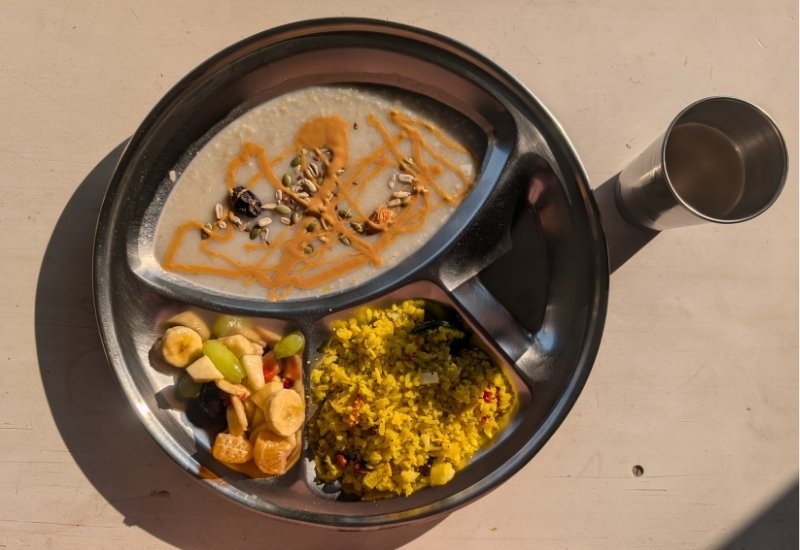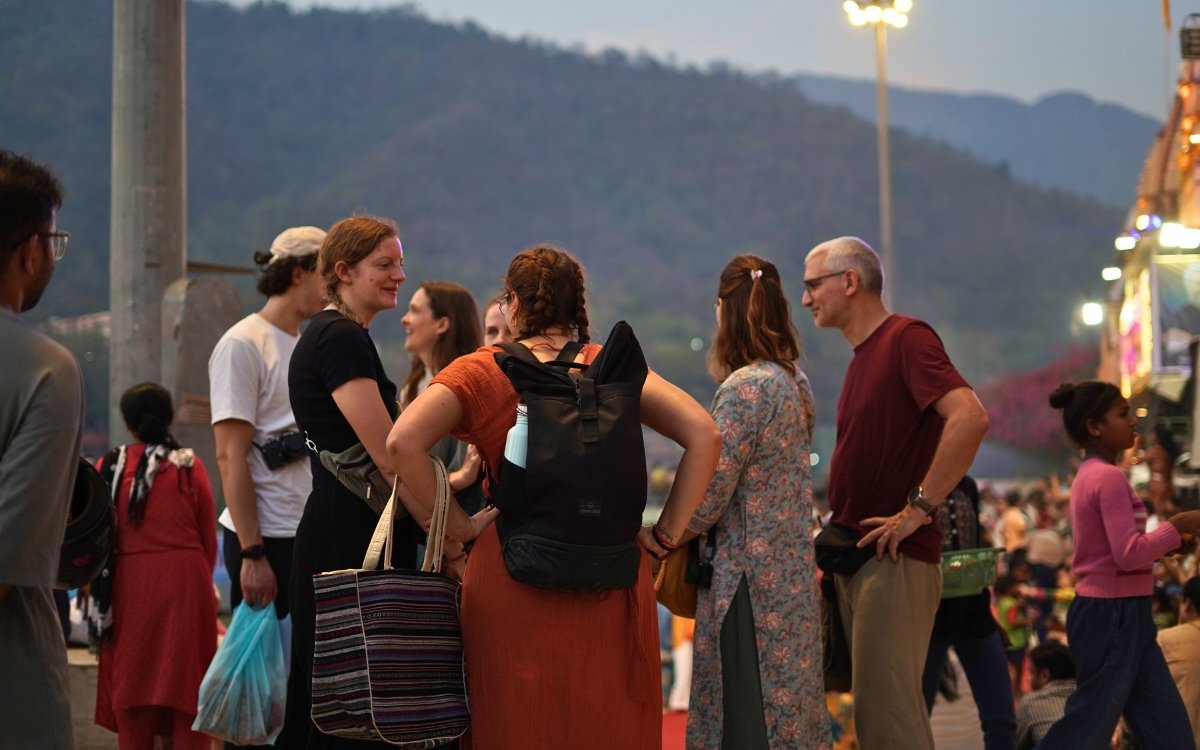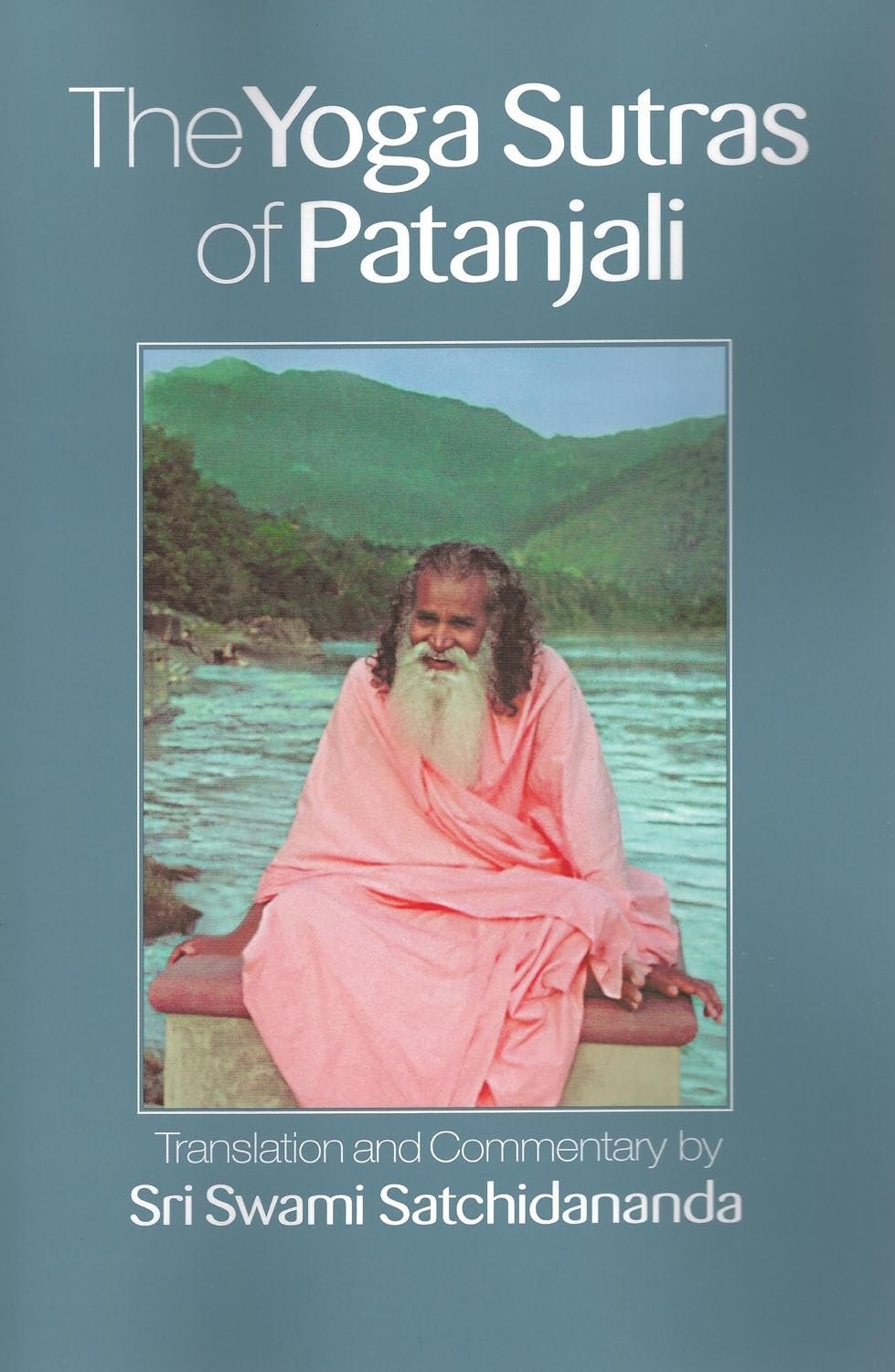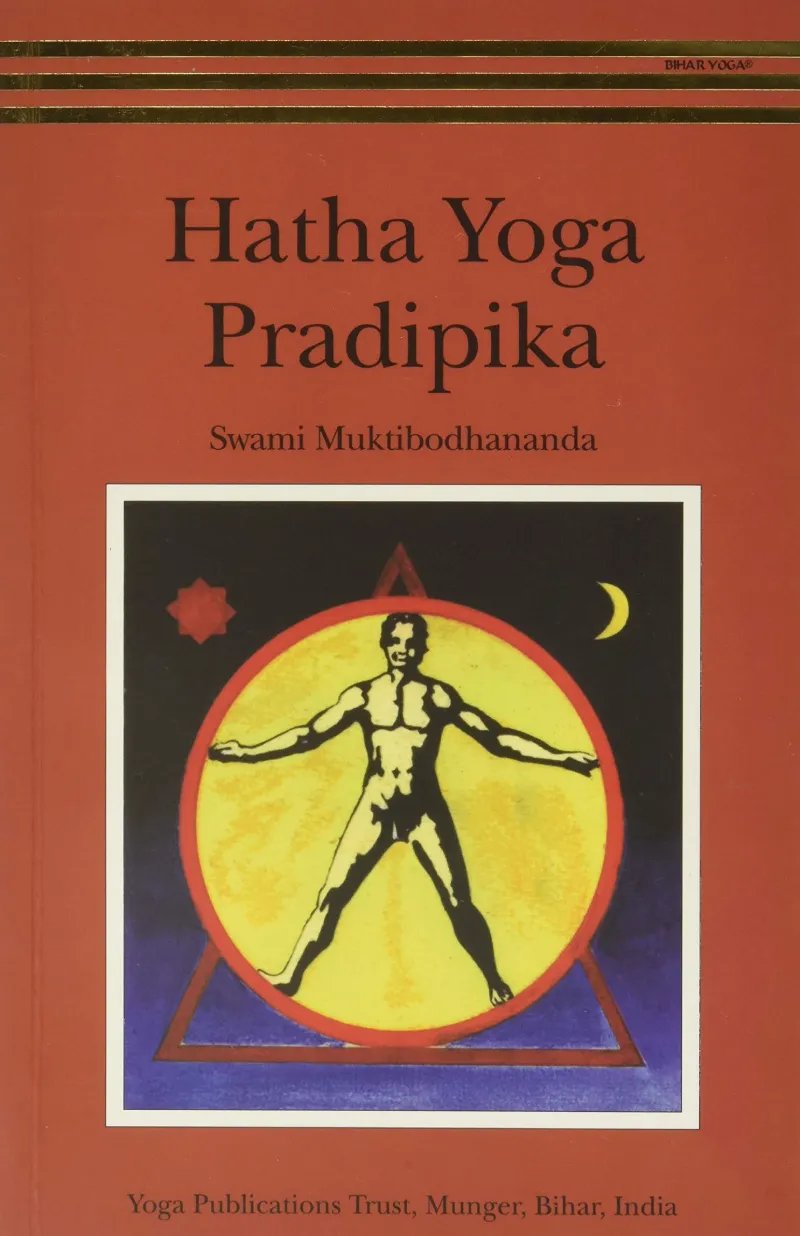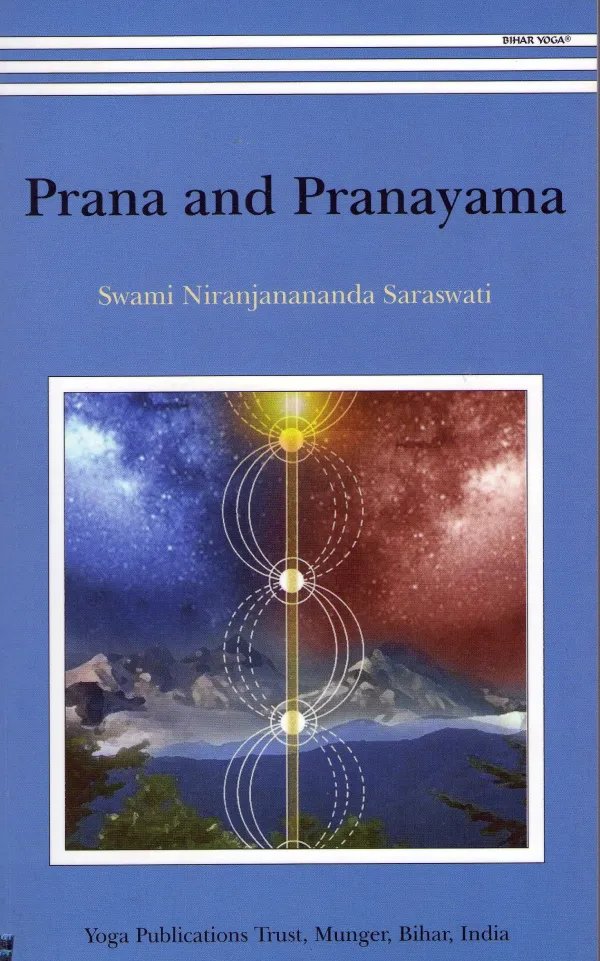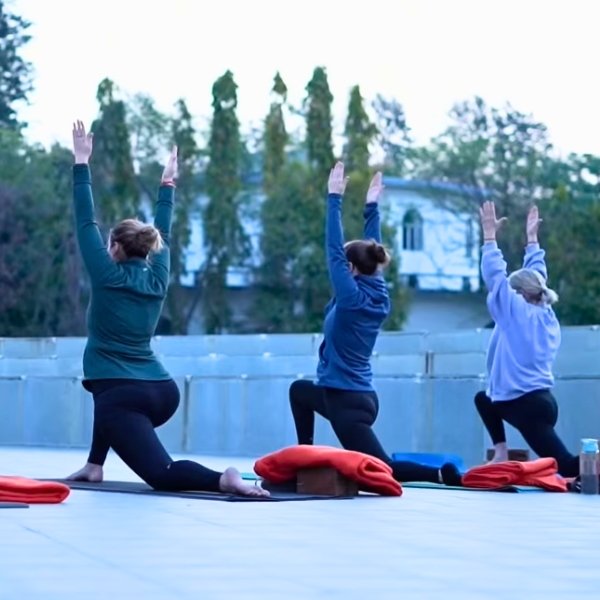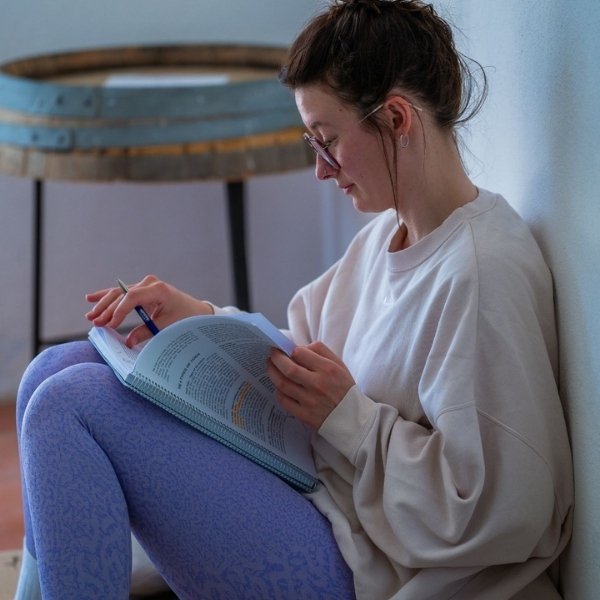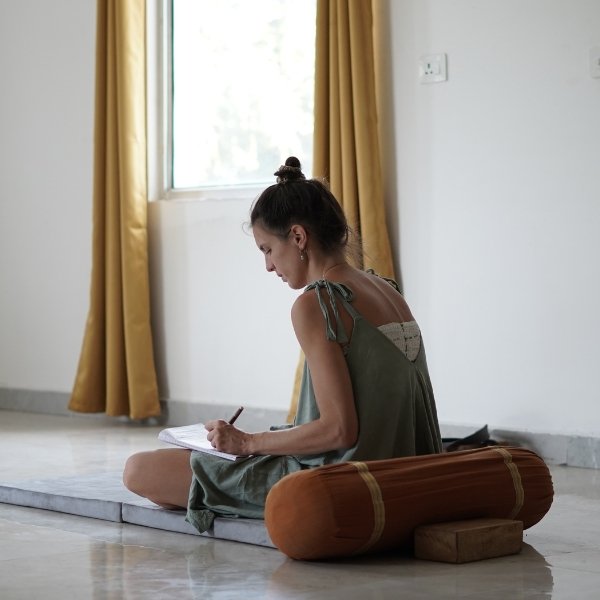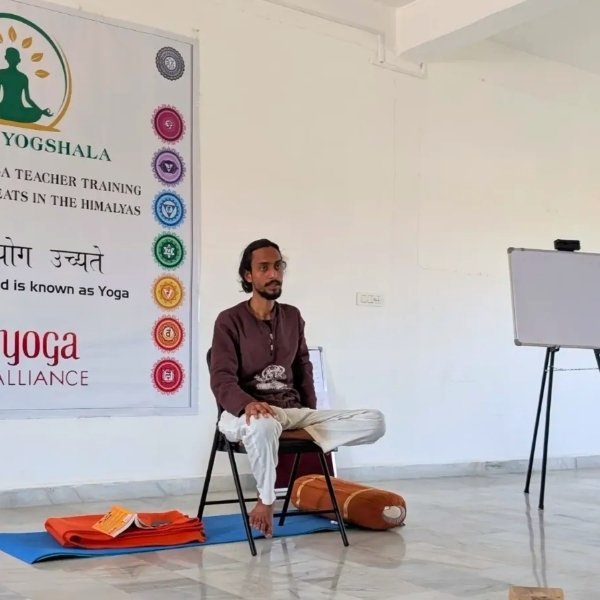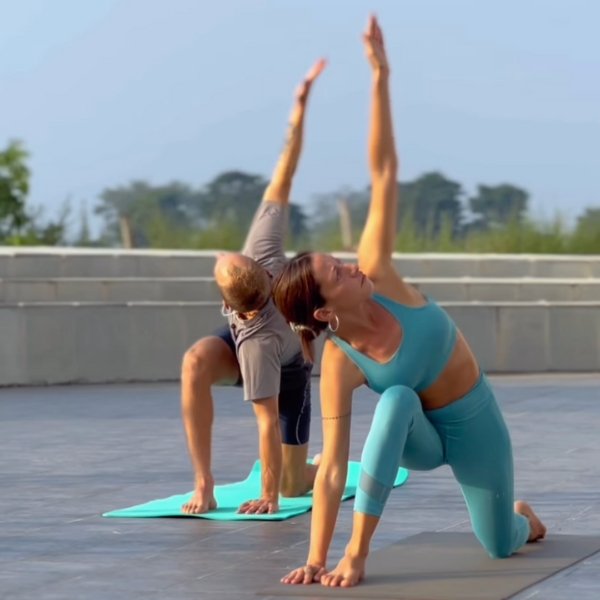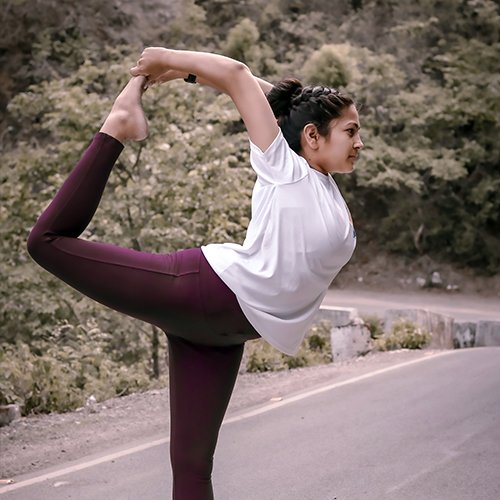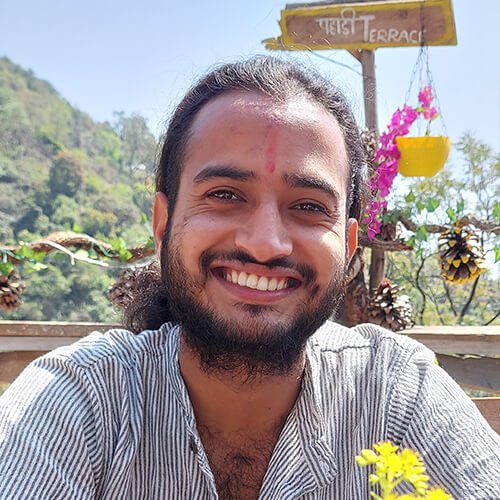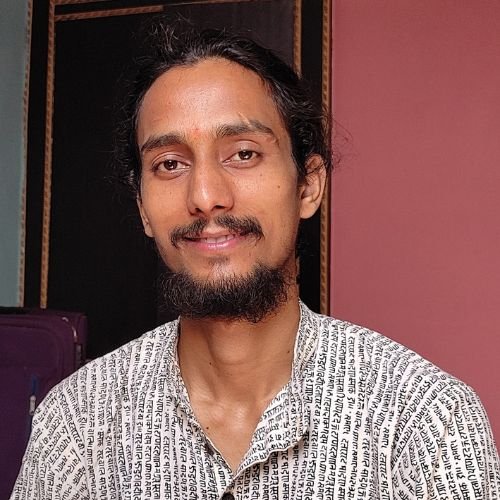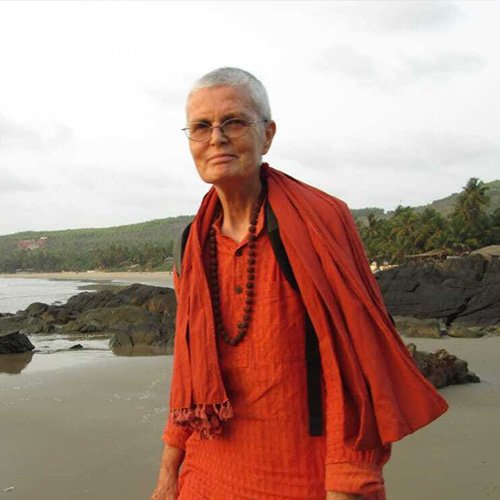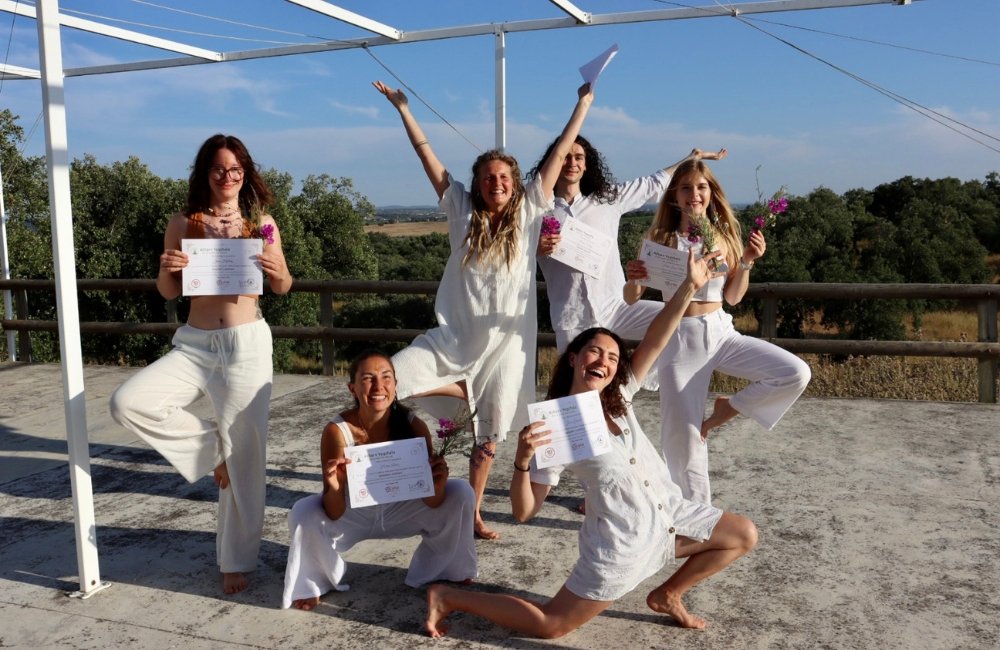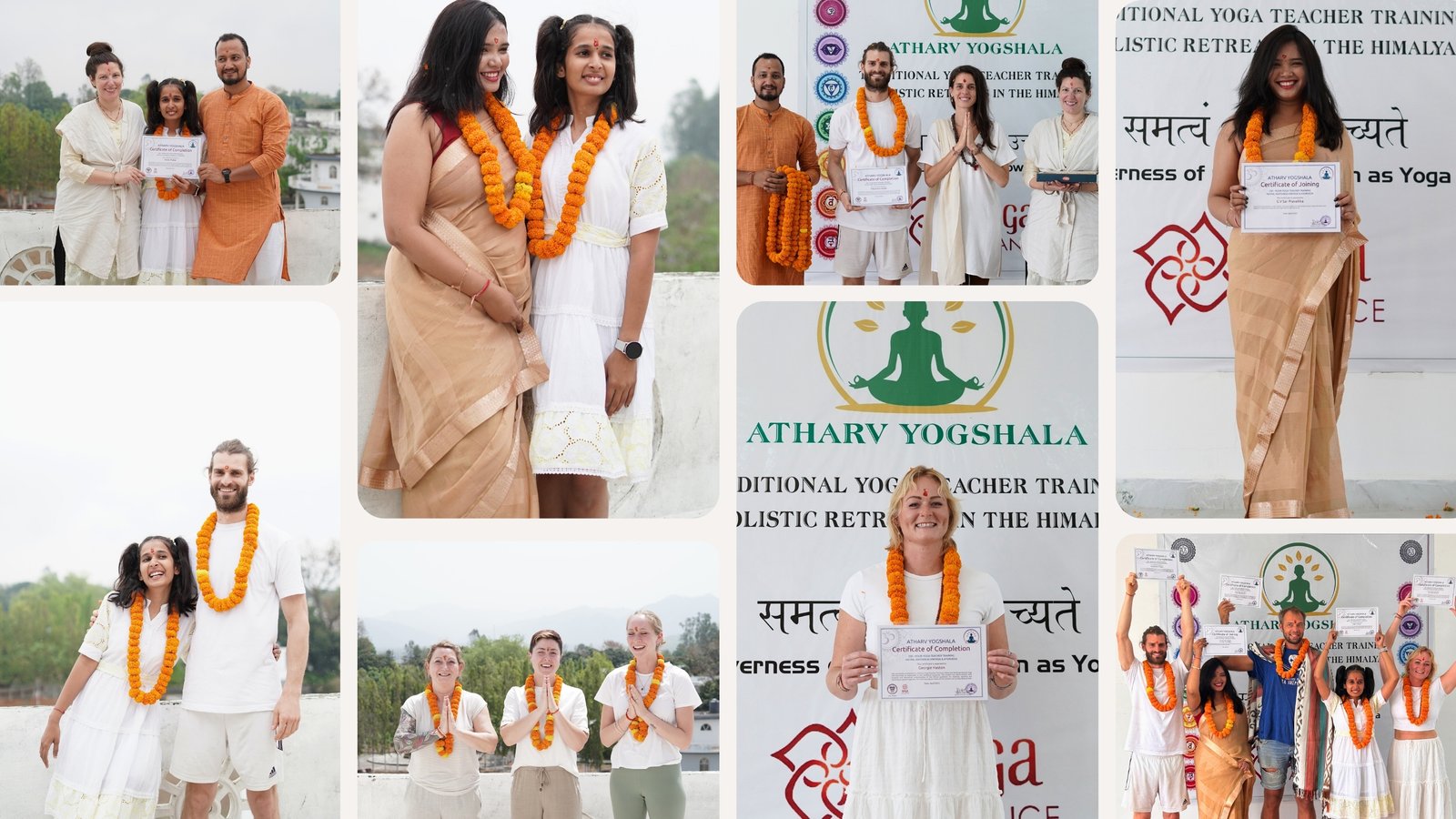200 Hour Yoga Teacher Training in Rishikesh

Atharv Yogshala is a registered yoga school located in a serene environment with a positive and enchanting atmosphere. It is a traditional school and close to scenic points of a particular location. We offer intense courses for the development of an individual. There are also extra classes based on Ayurveda knowledge. The school is equipped with all modern facilities.
Atharv Yogshala offers a secure and clean environment. You will get a chance to balance your life and get to transform it with us in the most promising way. We ensure to meet the needs of every student. We believe that the world is one family. We are offering authentic yoga learning. We have a modern touch to our studies, but the thing that makes us unique is that we don't change the core of them. The teachers and team of our yoga school in India and Nepal are well-experienced, with years of professional knowledge and training.
We have successfully conducted various batches of yoga courses and teacher training, covering the nuances of true yoga. It includes the syllabus with various topics like Yoga Asanas, Pranayama, Meditation, Yoga Sutras of Patanjali, Kriyas, Mudras, Hatha Yoga Pradipika, and more.
You need to attend the classes with the correct percentage, submit assignments, and pass exams to get the Yoga Alliance Certificate.
How Can This Course Transform Your Life as a Yoga Teacher?
Whether it is starting a career as a yoga teacher or something else that comes from your heart, teacher training gives you time to reflect on what you have done with your life so far and what truly matters to you.
Looking at your life from a distance allows you to make mindful choices about your lifestyle and career. Most people spend a great amount of their time at work. Therefore it is incredibly important for you to think about and realize what kind of work makes you happy. The fact that you decided to do the Yoga Teacher Training means you already dare to make profound changes.
As a result of the highly structured program at the school, you are trained to stick to a daily routine. You get up at fixed times and go to bed early. The food you eat is healthy and nutritious. And, of course, you practice yoga asanas every day. Sticking to this lifestyle for a whole month is very powerful and helps to develop new habits. In addition, there is little room for distraction. So eventually, this also helps you to break old and unnecessary habits. You simply cannot drink coffee every day, grab your phone all the time, or sleep too late or too long. And that is such a liberating experience that you will likely stick with it back home (or at least try).
Another positive effect of living the school life is that you're going back to basics. Life at the school is simple and disciplined. Sleeping in a simple room, eating the food that is provided, no internet connection. In other words: there is nothing more than you need. Simplifying your daily life is a powerful way to practice contentment - being happy with what you have without desiring more all the time. This can be a major shift in your experience of life after the teacher training. Even if there’s not a big difference in what you do, there will be a pivotal change in your way of experiencing, thinking, and acting.
Before attending a yoga teacher training, many people think of yoga as a way to strengthen their body and to empty or relax their mind. All of this is true to some extent, but it’s not the complete picture of yoga. A yoga teacher training provides you with an in-depth understanding of yoga philosophy. Furthermore, specific concepts such as karma yoga help you to understand human existence from a different perspective. It gives you a new frame of reference for your life experiences. This broadens your mind and provides you with unique insights that you can transfer to others.
When you practice yoga asanas at least twice a day, you will see quite amazing physical results. Yoga promotes muscle strength, flexibility, stamina, and improved functioning of the inner organs. Not only will you learn about the positive effects of each asana in more detail during the training, but you will experience these effects yourself.
Through the challenges of living at the school, disconnected from your familiar surroundings, it is not surprising that many people experience tremendous personal and mental growth. The teachers at the school can help you to expand your boundaries gently and to believe in yourself. For example, who could have believed that every single person could do and hold a headstand for a few minutes by the end of four weeks? These experiences make you realize you are often stronger than you think, and that is a lesson you will take with you for the rest of your life.
In addition to everything above, practicing yoga intensively throughout your teacher training allows you to get more in touch with yourself. Practicing meditation, pranayama, and yoga asana every day increases awareness as well as inner balance. Starting each morning with meditation promotes focus and clarity in your mind, going beyond automatic thinking patterns. Combined with more spiritual practices and self-study, this helps you to reconnect with who you are. Maybe this is not surprising, as the central question in yoga is: 'Who am I?'
The program of the Atharv Yoga teacher training course allows you to grow gradually and naturally into the role of a yoga teacher. The daily classes on teaching techniques and teaching practices from the first week onward allow you to improve your teaching skills. Moreover, the theoretical classes provide you with a firm understanding of the aim of yoga. The whole course is designed to prepare you for teaching yoga professionally with confidence and skill.
As there is so much to learn, yoga teacher training is a very humbling experience. You realize how much more you have to learn and that you are just at the beginning of a lifelong process. Although you will have a lot more knowledge and insights by the end of the teacher training, you will understand that this was just the first step. As the teachings of yoga are extensive, you will keep on learning your whole life. It will teach you to always remain a humble student and learn a lot more from the people coming to your classes.
Last but not least, the one thing that many people say after their teacher training is that they have built friendships for life. As you spend such an intense and transformative period together, you share your deepest thoughts and feelings. This creates a special bond that will last for the rest of your life.
Why Atharv Yogshala Is Considered The Top Choice For The 200-Hour Yoga TTC In Rishikesh?
Our 200-Hour Yoga Teacher Training in India is a comprehensive program designed to provide you with a deep understanding of yoga and its various practices. This course is perfect for individuals who are looking to deepen their knowledge of yoga, enhance their practice, and embark on a career as a yoga teacher. Our 200-Hour Yoga TTC program covers all aspects of yoga, including asanas (postures), pranayama (breathing techniques), meditation, anatomy, philosophy, and teaching methodology. We offer a multi-style approach, incorporating Hatha, Ashtanga, Vinyasa, and Yin yoga, to provide a well-rounded and diverse learning experience.
Our experienced and certified teachers will guide you every step of the way, providing personalized attention to help you develop your skills and knowledge of yoga. We place a strong emphasis on alignment and safety, ensuring that you learn how to practice and teach yoga safely and effectively. Upon completion of the 200- hour yoga training, you will receive a certification accredited by Yoga Alliance USA, which will allow you to teach yoga anywhere in the world. This is an internationally recognized certification and is highly respected in the yoga community.
What Will You Gain From This Course At Atharv Yogshala Yoga School?
Our 200-hour yoga teacher training in Rishikesh is designed to provide a comprehensive understanding of yoga and its various practices. The program covers all aspects of yoga, including asanas, pranayama, meditation, anatomy, philosophy, and teaching methodology. Our experienced and certified teachers will guide you every step of the way, providing personalized attention to help you develop your skills and knowledge of yoga. In addition to the training, you will also get to explore the beautiful Himalayas and the holy Ganges River, providing an immersive experience of Indian culture and spirituality.
You will get to participate in yoga classes and workshops, allowing you to deepen your understanding and practice of yoga. At the end of the program, you will be equipped with the knowledge and confidence to teach yoga to others and to start your journey as a professional yoga teacher. Our 200-hour yoga teacher training program in Rishikesh is an intensive yet rewarding experience that will transform your life.
Who is eligible for this course?
Currently, the need for yoga teachers in educational as well as corporate organizations is on the high rise. Unlike other physical exercises, where flex-and-stretch of muscles is very little and harmless, Yoga involves precise postures and controlled exercises which when performed incorrectly tend to cause serious pain to the muscle and possibility harm the body. Thus, acquiring professional training and a certificate in the profession is very crucial and essential to avoid misguided and wrong blunders to teach yoga.
At Atharv Yogshala we consider practitioners should be above 18 years old. And if you have any health-related problem please let us know before joining. Yoga Teachers should have an interest and belief in yoga; training and experience in yoga practice; a good level of personal fitness, strength, and flexibility. They also have a caring approach and an interest in people; the ability to motivate individuals and groups; Yoga Teachers need to have the ability to empathize with people of different abilities; be organized, be motivated self-starters, and have excellent anatomical knowledge.
Course Fees & Dates

Date
Fees
Availability
Booking

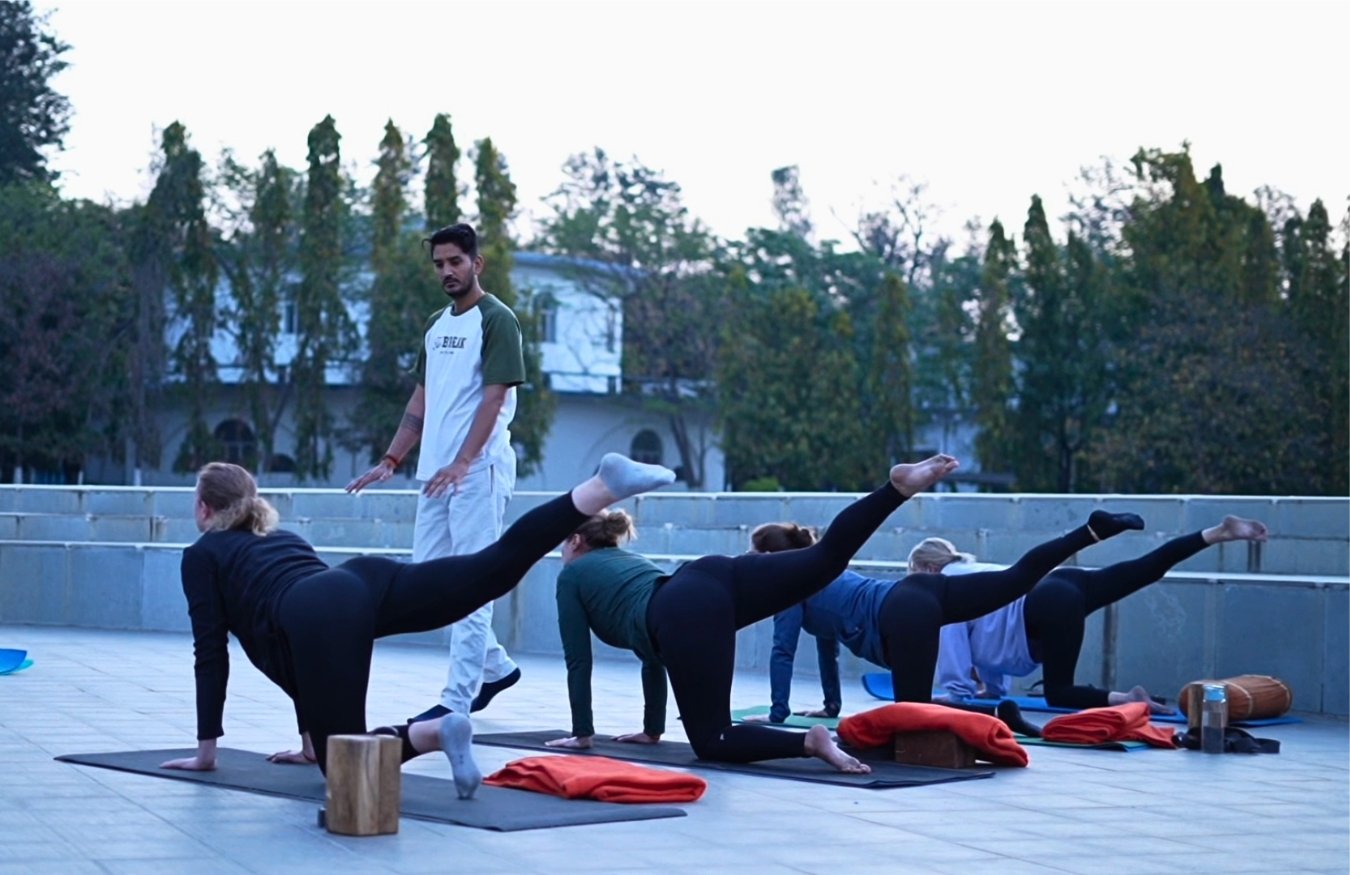
Course Inclusions & Exclusions

Yoga Certification - 200 Hour YTTC

All participants completing a 100 hour yoga training course are eligible to apply for 200 Hour Yoga TTC which is an internationally recognized yoga teacher certification and designation.
You will be able to develop your understanding of yoga at Atharv Yogshala to the point where you will be able to teach yoga professionally. Our graduates can apply to Yoga Alliance to become registered yoga teachers, such as RYT 200 and RYT 500, according to their qualifications.
Evaluation of 200 Hour Yoga TTC in Rishikesh
The overall evaluation of 200 hours Yoga teacher training at Atharv Yogshala India based on below assessment:
- Written assessment - Completion of assignment
- Practical assessment - designing, sequencialising and conducting Yoga session
- Student's conduct throughout the training will be an essential criteria
- Attendance - minimum 90% wherein student must have presented the valid and agreed reason for 10% absenteeism

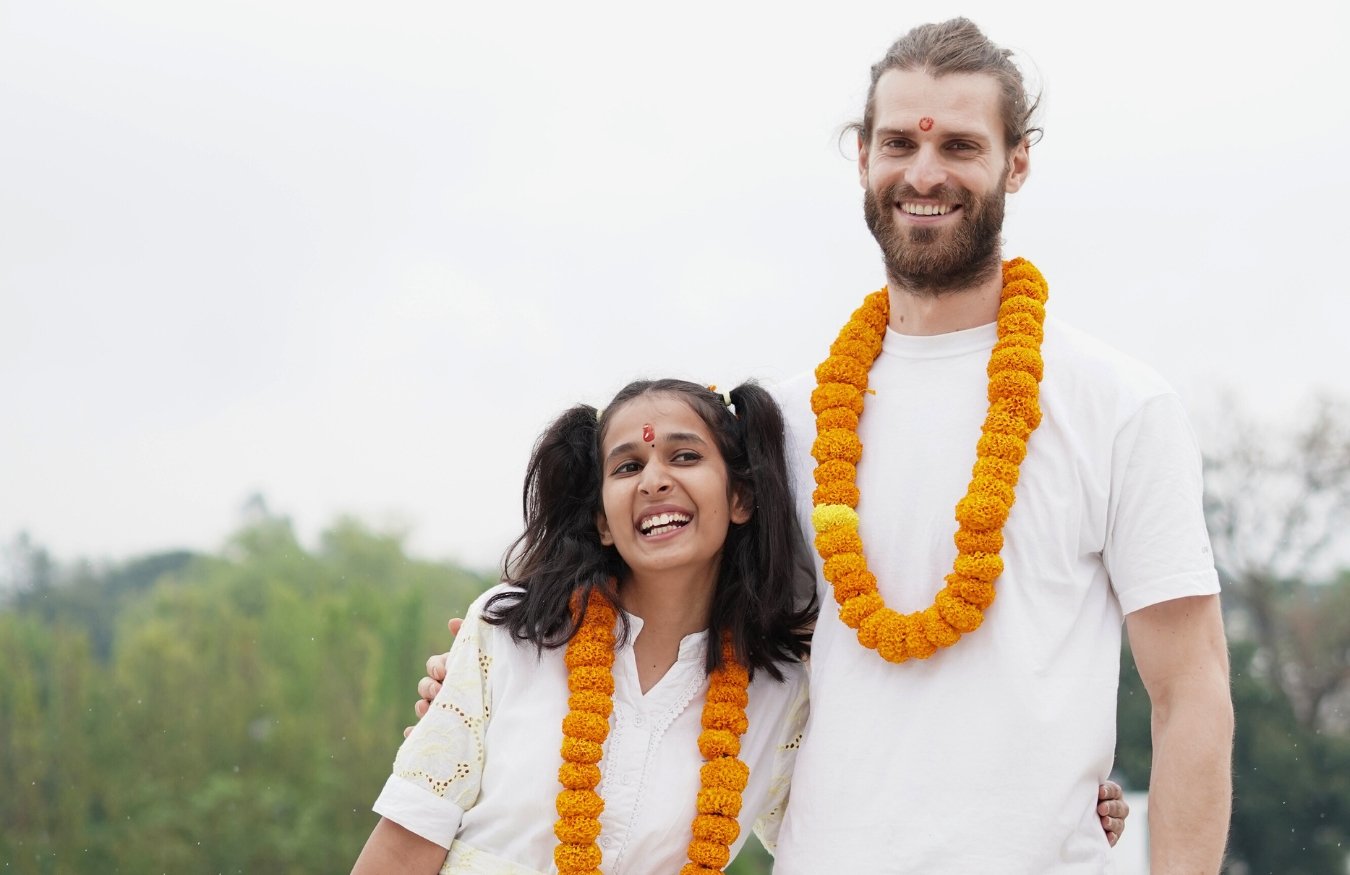
Course Syllabus: 200 Hour YTTC

At Atharv Yogshala, we offer various yoga teacher training courses to students who are willing to learn the best in the field of yoga and meditation. The curriculum is entirely based on Yoga Alliance standards. We offer residential courses with extra classes in Ayurveda. With our course, we aim to balance our lives and transform them in a positive way. We work in the belief that the world is one family, and with our courses, it is our duty to meet the needs of every individual.
110 Hours
Techniques, Training and Practice
Asana | Assignment | Pranayama | Meditation
20 Hours
Anatomy & Physiology
Introduction to Body and More
30 Hours
Yoga Humanities
History | Philosophy | Ethics
40 Hours
Professional Essentials
Teaching Methodology | Professional Development | Practicum
- Art of Mantra
- Science of Mantra
- Power of Mantra
- Formation of Mantra
- Mantra Chanting
Mantra Chanting is a powerful tool which develops a spiritual connection inside you. It, in turn, creates a balance between the body, mind, and spirit.
- How to chant the mantra properly?
- Om Mantra
- Peaceful Shiva Mantra
- Energetic Durga Mantra
- Joyous Krishna Mantra
- Gayatri Mantra for the purification of the mind
- Sahana Mantra for Guru Disciple Study
- Guru Mantra for paying homage to Guru
Traditional Hatha Yoga sessions conducted by our school are a positive workout for one's physical and mental wellness. It originated years ago with the aim to attain health and peace. The practice also benefits you with strength and flexibility.
- Pavan Muktasana series 1 (Antirheumatic Exercise series 1)
- Pavan Muktasana series 2 (Antirheumatic Exercise series 2)
- Pavan Muktasana series 3 (Antirheumatic Exercise series 3)
- Centering postures series (Yoga Sequence Builder)
- Surya Namaskar (Sun Salutation)
- Standing postures series
- Kneeling postures series
- Sitting Postures series
- Forward bending postures series
- Backwards bending postures series
- Supine postures series
- Prone Postures series
- Fire Series series
- Inversions series
- Twisting postures series
- Balancing Postures series
- Relaxing Posture series
- Meditative Asana Series
- Theory of Hatha Yoga
- Ancient Scriptures & Texts of Hatha Yoga
- Aim and Objectives
- Yoga as a Therapy
- Yoga as Balancing
More than a teaching session conducted by yog gurus, Mysore Style Ashtanga Yoga is a self-assisted and practice class. All students are doing the same sequence and postures, supported by experienced teachers.
- Introduction
- History
- Awakening the Inner Fire
- The Breath of Life (Prana)
- Chakras
- Eight Limbs of Yoga (Ashtanga Yoga)
- The practice of K.Pattabhi Jois
- Bandha practice
- Drishti (Focusing the Attention)
- Use of yoga props and instruments
- Sun Salutation A & B (week 1) - Surya Namaskar Series A & B
- Standing Asana Series (week 2)
- Sitting Asana Series (Week 3)
- Finishing Asana Series (Week 3)
- Teaching Practices (Traditional & Mysore Style- Week 4)
- Padangustasana (Big toes Posture)
- Pada hastasana (Hand under foot posture)
- Utthita trikoṇasana (A+B) (Triangle posture)
- Utthita parsvakonasana (A+B) (Extended side angle pose)
- Prasarita padottanasana (A,B,C,D) (Intense wide leg stretch)
- Parsvottanasana (Intense side stretch posture)
- Utthita hasta padangustasana (Hand to big toe posture)
- Ardha bandha padmottanasana (Half-bound lotus forward bend)
- Utkatasana (Fierce pose)
- Virabhadrasana (Warrier pose) A+B
- Dandasana (Staff pose)
- Pascimattanasana (Intense west stretch or sitting forward bend)
- Purvattanasana (Intense east stretch)
- Ardha bandha padma pascimattanasana (Half bound lotus forward bend)
- Tiryangmukha Eka pada pascimattanasana (Reverse the leg, one leg intense stretch)
- Janusirsasana (Head-to-knee pose)
- Marichyasana (Leg Binding Pose)
- Navasana (Boat Pose)
- Bhujapiḍasana (Shoulder Pressure Pose)
- Kurmasana (Tortoise Pose)
- Suptakurmasana (Reclining Turtle Pose Yoga)
- Garbhapindasana (Womb Pose)
- Kukkutasana (Cockerel Pose, or Rooster Posture)
- Baddha Konasana (Bound Angle Pose, Butterfly Pose)
- Upavistha Konasana (Seated Angle Posture)
- Suptakonasana
- Supta Padangustasna
- Ubhaya Padangustasna
- Urdhvamukha Pascimattanasana
- Setubandhasana (Bridge Pose)
- Finishing Postures
- Urdhva Dhanurasana (upward bow posture)
- Salaṁba sarvangasana (shoulder stand posture)
- Halasana (plough posture)
- Karṇa pidasana (ear pressure posture)
- Baddha padmasana (sealed lotus pose)
- yoga mudra (sealed yoga posture)
- Padmasana (Lotus posture)
- Savasana (Corpse pose)
Prana, the life energy Yama means control. It is the foundation practice of the traditional form of yoga. It is not just a breathing practice but much more than this. The class of pranayama reveals its secrets and the power of pranayama to gain the right health, peace, and balance.
The four week course offers a different experience, such as;
- Week 1: Step wise knowledge of pranayama and building strength.
- Week 2: From the beginning to the deep core of pranayama.
- Week 3: Advance practice by holding the breath and manifesting chakra awareness.
- Week 4: Teaching practice while moving to the master level of the breath.
Pranayama Topics:
- Definition of Prana
- Definition of Pranayama
- Definition of breath
- Connection of the Prana and the breath
- Importance of Pranayama
- Benefits of Pranayama
- Preparing ourselves to practice pranayama
- Aspects of Breathing
- Ancient Texts of Breathing
- General understanding
- Knowledge of nostrils
- Activating nostrils for pranayama
- Secrets of Pranayama
- Breath flow in 5 elements
- Unit of Prana
- Function of Prana
- Three levels of Prana
- Three Gunas
- Flow of Prana
- Quality of breath
- Imbalance of Prana
- Retention of breath
- 6 Sitting postures for Pranayama practices
- Breathing pattern
- Chakras and Kundalini connect with Prana
- Beginners and Intermediate Practices of Pranayama
- Clavicular Pranayama
- Thoracic Pranayama
- Diaphragmatic Pranayama
- Yogic Pranayama
- Pranava Pranayama (Om Meditation Breathing)
- Nadi Shodhana Pranayama or Anulom Vilom Pranayama
- Bhastrika Pranayama (Bellows Breath)
- Kapalbhati Pranayama (Skull Shining Breath)
- Bhramari Pranayama (Humming Bee Breath)
- Ujjayi Pranayama (Ocean Breath)
- Sitali Pranayama (Cooling Breath)
- Sitkari Pranayama (Hissing Breath)
- Murcha Pranayama (Swooning Breath Yoga)
- Surya Bhedi Pranayama (Right Nostril Breathing)
- Chandra Bhedi Pranayama (Left Nostril Breathing)
Just like you involve your body in physical exercise for its benefits, in the same way, meditation is an exercise for mental health. With the power of meditation, you can control your mind and block negative and unnecessary thoughts. You enter into a deep state of relaxation where peace is the ultimate goal. During the meditation class, you are advised to sit quietly by keeping your focus on a single thing. It helps you in eliminating tension and stress. With the 200 Hours yoga teacher training course, you get to learn basic and intermediate techniques of meditation.
The four weeks program work as;
- Week 1: Introducing Meditation and Building Foundation
- Week 2: Making the mind able to focus on a single aspect with concentration process and exercises.
- Week 3: Meditation Techniques
- Week 4: Chakra Awareness and Kundalini Meditation
What'll you learn?
- What is Meditation?
- History and Origin of Meditation
- How to prepare yourself for Meditation?
- What Meditation is actually?
- What Meditation is not?
- Why to meditate?
- How to meditate?
- Where to meditate?
- When to meditate?
- Philosophy of Meditation
- Meditation Traditions
- Meditation Scriptures
- Aim and Objectives of Meditation
- Sitting Positions
- How to Sit Correctly
- Preliminary Practices Before Practicing Meditation
- Diaphragmatic Breathing in Meditation
- Correct Breathing in Meditation
- How to Relax in Meditation?
- Lifestyle in Meditation
- Diet of Meditation
- Why should one sleep while meditating?
- What are the rules of meditation?
- Styles of Meditation Practices
- Himalayan Meditation Practices
- Basics Foundation Meditation Practice
- Breath- Mind- Mantra Awareness
- Trataka Meditation
- Nada Meditation Practices
- Music Meditation
- Om Meditation
- Mantra Power Meditation
- Active Meditation Practices
- Dynamic Moving Meditation (Osho)
- Buddha Walking Meditation
- Karma Yoga Meditation
- Natraj Meditation
- Sufi Meditation
- Gaurishankar Meditation
- Ajna Chakra Awakening Meditation
- Kundalini Active Meditation
- Vipassana & Passive Meditation Practices
- Breath Awareness (Anapana)
- Mindfulness and Sensation
- Total Awareness Practice
- How to Do Japa (recitation)
- Kirtan Even and Creating a Spiritual Vibe
- One-Day Silence Meditation
- Silence Practice
Yoga Nidra is also known as Psychic Sleep. The practice creates a state between waking and sleeping. It is a state of consciousness. One can go into this deep and conscious sleep with the practice of guided meditation. Yoga Nidra can also be termed as the victory over sleep. You can relax your mind and complete the sleep of 8 hours in just a short practice of yoga nidra. When you go through the epic, Mahabharata, you get to know that Arjuna (one of the Pandavas) was associated with Yoga Nidra.
The four-week program of Yoga Nidra includes;
- Week 1: Basic Relaxation Practices
- Week 2: Visualisation Yoga Nidra
- Week 3: Chakra Awareness Yoga Nidra
- Week 4: Inner Flame Yoga Nidra What'll you learn?
- Basics of Yoga Nidra
- Meaning of Yoga Nidra
- Purpose of Yoga Nidra
- Different Schools of Yoga Nidra
- Traditions of Yoga Nidra
- Tantric Origin of Yoga Nidra
- Lifestyle for Yoga Nidra Practitioners
- Rules for Yoga Nidra Practitioners
- Benefits of Yoga Nidra
- Risks of Yoga Nidra
- Difference Between Yoga Nidra and Meditation
- Yoga Nidra Experience
- Yoga Nidra and Healing
- 4 States of Consciousness
- 3 Body Awareness
- Tension Relaxation
"Shat" means "Six" and "Karma" means "Actions". Thus, as per yogic science, Shatkarma is six cleansing actions that help to clean your body and mind. It is well described in the Hatha Yoga Tradition. Shatkarma is an important practice to maintain a balance between body and mind and also promote well-being. The practice eliminates toxins from the body and unblocks energy channels.
With the 100,200,300 Hours Yoga TTC, you will learn;
- Introduction to Shatkarma
- Benefits of Shatkarma
- Risks of Shatkarma
- Who should practice it?
- Who should not practice it?
- Experiences
- Preparation to Shatkarma
- Practices After Completing It
- Cleansing of Nadis or Energy Channels
- Practices that you will learn
- Jihwa Dhauti (Tongue Cleansing)
- Danta Dhauti (Teeth Cleansing)
- Karna Dhauti (Ear Cleansing)
- Jalaneti (Cleansing with Water)
- Kapalbhati (Mind Cleansing)
- Agnisara (Cleansing with Fire)
Yoga Philosophy is a powerful subject that can change one's life. Many are confused that it only exists in Patanjali's Yoga Sutras but this is not true. It is the philosophy of life which can also be found in Bhagwat Geeta, Hatha Yoga Pradipika and Upanishads. The basic and main philosophy of yoga is simple, body, mind, and soul are one and one can not separate them.
During the 4 weeks of the 200 Hours Yoga Course, Yoga Philosophy will explain to you the motive of life.
Week 1: The World of Wisdom
- Introduction to Indian Culture
- Spirituality and Himalayan Tradition
- Introduction to the Ancient Scriptures of Yoga and Spirituality
- Meaning of Indian Philosophy
- Purpose of Indian Philosophy
- Introduction to 9 Major Indian Philosophy
- What is Yoga Philosophy the Most Important among All?
- History of Yoga
- Types of Yoga
Week 2: Yoga Sutras of Patanjali
- Patanjali and His Work
- Introduction to Yoga Sutras Text
- Eight Limbs of Yoga (Ahimsa, Satya, Asteya, Brahmacharya, Aparigraha, Saucha, Santosha, and Tapas)
- Yamas & Niyamas
- Philosophy of Asana & Pranayama
- Karmic Science
Week 3: Internal Limbs
- Concentration, Meditation, and Samadhi
- First Chapter
- Second Chapter
- Third and Fourth Chapters of Patanjali
- Mind and Its Control
- Introduction to Bhagavat Geeta & Upanishad
Week 4: Exploring the wisdom of Yoga
- Chakras
- Nadi
- Kundalini
- Three Fold Pain
- Three Bodies (Sharira)
- Pancha kosha
- Tri-guna
- Mahabhuta (Theory of Elements)
In yoga, anatomy is a crucial subject for yoga teachers and learners. In the class, you will get to know physical anatomy and spiritual anatomy.
- Physical Anatomy
- Introduction to Body
- Bodily Structures
- Body Planes
- Anatomical Movements
- Bones of the Skull
- Cervical Vertebrae
- Shoulder Girdle/ Arm Bones/ Pelvic Region
- Deformities of the Spine
- Lower Extremity
- Tendons and Ligaments
- Muscular System
- Nervous System
- Respiratory System
- Spiritual Anatomy
- Nadi (Energy Channel)
- Chakras (Energy Centres)
- Kundalini (Prime Energy and Souce of All Creativity)
- Pancha kosha (5 Layers)
- Pancha Mahabhuta (5 Elements and Body Structure)
- Tri-Guna (Three Attributes)
Ayurveda is the oldest and the most natural system of medicine that originated in India years ago. It is approximately 3000 years ago medicinal science. Ayurveda is derived from two words, "Ayur" means "Life" and "Veda" means "Science", thus Ayurveda describes the meaning "Science of Life" or 'Knowledge of Life'. As per Ayurvedic Science, the body is made up of five elements, i.e. Akash (Ether), Vayu (Air), Agni (Fire), Apas (Water), and Prithvi (Earth). These 5 elements create 3 doshas namely, Kapha, Vata and Pitta. When these are balanced, then an individual remains healthy and when these are imbalances, an individual remains ill. Ayurveda helps in balancing all of these to give you a healthy lifestyle.
The 200 Hours Yoga Course explains;
- What is Ayurveda?
- Ayurvedic Treatment and its Unique Features
- Ayurveda and Its Diversified Areas
- Ashtanga Ayurveda
- Fundamentals of Ayurveda
- Panchamahabhuta [Earth (Prithvi), Water (Jal), Fire (Agni), Air (Vayu) and Aether / Space (Aakash)]
- Kapha
- Vata
- Pitta
- Prakriti- Know Your Constitution
Mudra is a symbolic gesture. It is normally practices with hands and fingers, explaining the flow of energy in the subtle body. It brings a wondrous change in body and mind.
The 200 Hours Yoga Course explains;
- The Secrets of Mudra
- The Position of Elements in the Hands
- The Need for Mudra
- Advantages of Mudras
- Special Guidelines About Mudra
- Gyan Mudra (Gesture of Wisdom)
- Purn Gyan Mudra (Gesture of Complete Wisdom)
- Vairagya Mudra (Gesture of Dispassion)
- Abhaya Mudra (Gesture of Fearlessness)
- Dhyana Mudra (Meditation Mudra)
- Vayu Mudra (Gesture of Air)
- Pran Mudra (Gesture of Prana)
- Prithvi Mudra (Gesture of Earth)
- Surya Mudra (Gesture of Sun)
- Varun Mudra (Gesture of God of Water)
- Shoonya mudra (Gesture of Openness, Space)
- Pran-Apan Mudra (Gesture of Prana Apana)
Bandhas is the Sanskrit word which means Lock. The aim of it is to block the energy flow from a particular part of the body. When the lock is opened, then the energy flows properly throughout the body and maintains overall wellness and vitality.
- Meaning and Importance of Energy Lock
- Why the Energy Lock and How Our Energy Gets Drained
- Energy Knots and How to Open Them
- Understanding the Three Chakras (Muladhara, Manipura, Visuddhi)
- Experience with Energy Lock
- Benefits and Risks of Bandha Practices
- Practices (Beginners and Intermediate Level)
- Agnisar (Preparation to Uddiyana)
- Vahir Kumbhaka (External Retention)
- Antar Kumbhaka (Internal Rentention)
- Ashwini Mudra to prepare Mulabandha
- Vajroli Mudra to prepare Mulabandha
- Mula bandhas (Root lock)
- Uddiyana bandha (Abdominal lock)
- Jalandhar Bandha (Throat Lock)
While being a student, it is also necessary to learn to teach. You are on a journey from being a student to a teacher.
- Proper sequence
- Avoid injuries
- Happiness during and after the practice
- Work with various styles of yoga and in all levels
- Meditative experience
- Managing the energy flow
- Balancing the energy flow
What you'll learn?
- Proper demonstration of a Yoga practice
- The proper way to instruct and guide a lesson
- Proper alignment of yoga postures
- Proper adjustment with/ without props
- Yogic personality establishment
In yoga, alignment is the right way to perform any asana so that one can minimise the risk of injury and reap maximum benefits from it.
What'll you learn?
- Sense of alignment
- Role of alignment in daily practice
- Balancing prana & chakras
- Alignment and 5 koshas
- Importance of Alignment
- A different aspect of Alignment
- Minimising the risk of injuries
- Increase the movement of joints
- Alignment based on body regions
- Upper Limb alignment
- Lower Limb alignment
- Torso – Thorax - Abdomen – Pelvis Alignment
- Alignment of Head & Neck
- Alignment of the spine
- Basic postures of alignment
- Bringing the body into comfortable zone
- Balancing the body and mind
Adjustment in yoga is also about learning the correct technique of yoga.
You'll learn;
- What is yoga adjustment?
- Sense of yoga adjustment
- Level of yoga adjustment
- Why adjustment is needed in yoga asana
- Role of adjustments in yoga asana class
- The right technique for perfect adjustment
- Bandhas
- Dynamics of each asana
- How to adjust self adjust in a posture
- How to adjust to others during the class
- Methods of Adjustment
- Tools and props to achieve the peak in the posture
- Body weight management
- Safety rules
- Preparations for adjustment
- Performance during the course
- Attendance
- Practical asana demonstration test
- Written test (Objective and subjective type)
- Behavior
Daily Yoga Schedule

The 200 hour Yoga Teacher Training Course at Atharv Yogshala follows a strict schedule in compliance with Yoga Alliance standards. Nearly 6 to 7 hours of training time are assigned to some aspect of yoga each day. You could find the training intensive but enlightening.
Time
Activity
Schedule on Wednesday
Time
Activity
Please Note: Excursions will be in the Morning / Afternoon / Evening time.
Schedule on Sunday
- Whole day is Rest / Holiday / Field Visits / Outdoor Excursions
- Includes Breakfast / Lunch / Dinner in Campus
Study Materials / Give-away
- Yoga Manual
- Notebook
- Jal Neti Pot, Rubber Neti
- School Bag
- School T-Shirt
Excursions During The Course

Understanding the local spiritual heart is key for our yoga students. Our program offers enriching and peaceful excursions to Yogic Caves, the holy Ganges River, the majestic Himalayas, local cultural spots, and other inspiring destinations.

Kunjapuri : Sunrise Tour
Visit Kunjapuri Temple, a revered Shakti Peeth in the Himalayas. At 1600m, enjoy views of snow-capped peaks and the Ganga River from this ancient and beautiful temple. Experience a serene sunrise.

Ganga Aarti - Rishikesh
Witness the Ganga Aarti in Rishikesh, a daily ritual with Vedic chants and prayers to fire. Held at Triveni Ghat and Parmarth Niketan, hundreds join physically, and thousands more virtually, for this spiritual experience.

Itharana Village : Nature Walk
Escape to Itharana, a peaceful Himalayan village. Engage in activities that connect you with nature, away from city life's noise. Experience the tranquility of a rustic setting and enjoy the natural beauty.

Bhootnath Temple
Bhootnath Temple, dedicated to Lord Shiva, is in the Swargashram area behind Parmarth Niketan. This multi-story temple offers amazing panoramic views of Rishikesh from its small main temple on the top floor.
Accommodation & Food

Atharv Yogshala's stay and meals are truly based on yogic patterns. Our accommodation is situated in a beautiful quiet place, a wholly isolated space just outside of Rishikesh. You will be surrounded by nature away from the chaos and busy everyday life and feel calm as soon as you enter the school premises.Atharv Yogshala is a beautiful place for nature lovers and perfect for meditation and finding your true self.
At Atharv yogshala we follow the ashram principals An ashram is a place of temporary retreat where great effort is undertaken to accelerate the transformation process towards self-realization. It is a place of spiritual retreat and growth where you come to know yourself.
An ashram fosters and encourages various types of discipline without which hard work and effort are not possible. It also teaches us how to live with simplicity, rather than indulging in the passing whims of fashion or social trends. The very atmosphere of the ashram environment is infused with spiritual ideals for us to reflect on and absorb.
Stay at Atharv Yogshala
Rishikesh - The small city in Uttarakhand, is undoubtedly the prime choice for yoga lovers, from all over the world. It is also known as the "World's Capital of Yoga." The spiritual atmosphere of the city makes it more vibrant and divine. It is a yoga-centric city. All fully furnished rooms are spacious and well-appointed.
You will find every modern facility in a secure and clean environment at our premises. They are cleaned regularly and have a cabinet and attached bathroom for your convenience. Also, there is a big dining hall where all students dine together and share their thoughts. Free Wi-Fi and laundry facilities are also available. We have the supportive environment and calm atmosphere needed for spiritual growth.


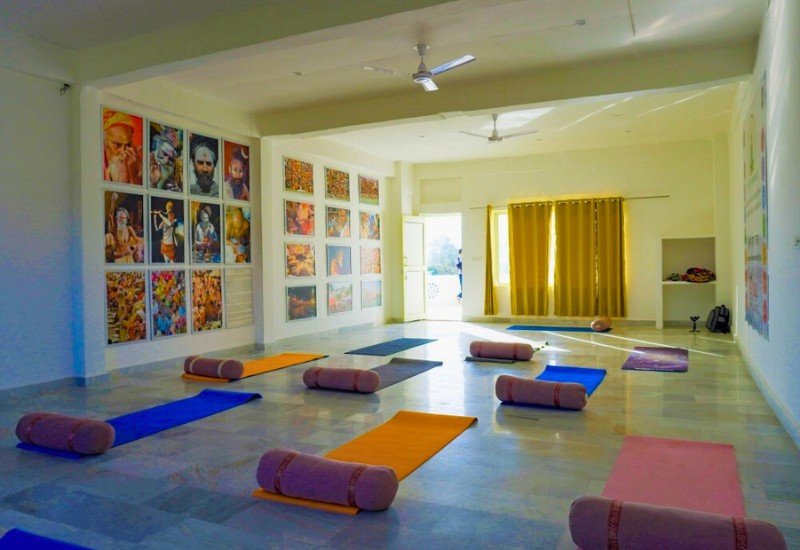



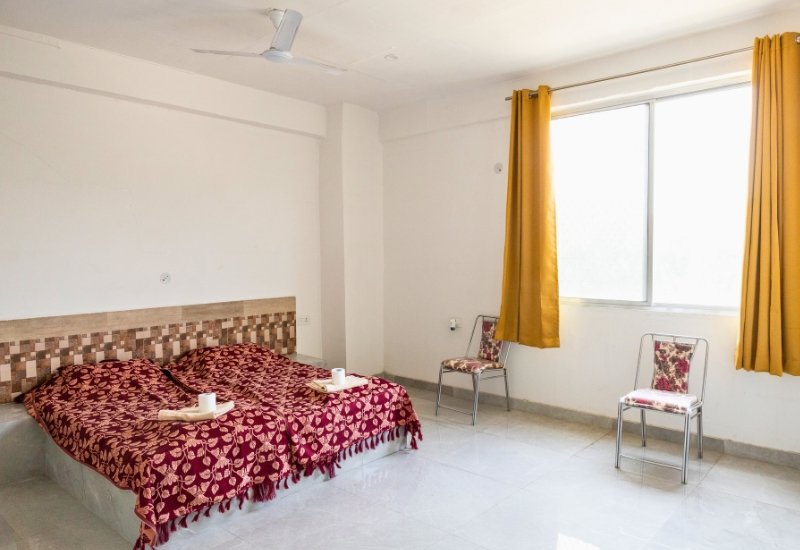











Yogic Meals at Atharv Yogshala
Atharv Yogshala offers three times a day freshly cooked meals, herbal tea and filtered drinking water. Atharv Yogshala Sattvic diet primarily consumes nutritious foods, including fresh produce and nuts, which is why this diet may lead to a number of health benefits. However, it’s quite restrictive, and many healthy foods are off-limits.
Living a healthy lifestyle is the expectation of everyone but very few obey the rule of living a healthy life. Eating Satvic food will give you good health, good nutrition and improves digestion. Sattvic food is very natural since it includes all fresh and medicinal ingredients. The diet is so natural that you don’t feel heavy or lethargic after eating and gives a peaceful feeling so here in Atharv Yogshala yoga practitioners slowly start incorporating Satvic food in theirs diet and learn to cook varieties of tasty dishes because this is going to show wonderful results in your body starting from good health, good energy boost and positive state of mind.
